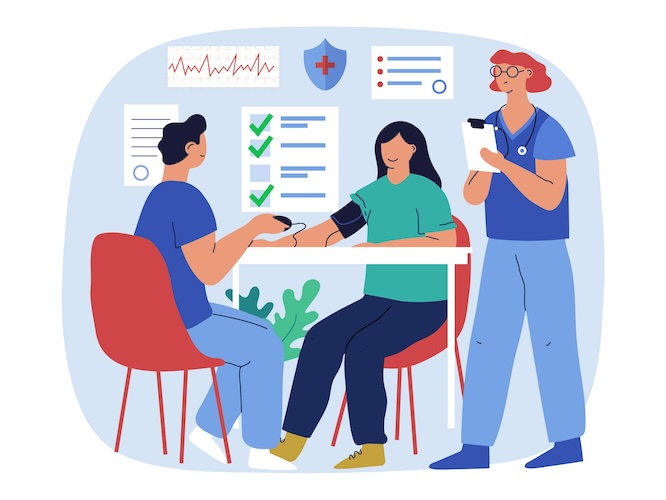In an era where efficiency is paramount, healthcare providers are increasingly looking to technology to streamline operations. One standout solution is to automate patient intake management.
Imagine a patient intake process that eliminates tedious paperwork, reduces waiting times, and enhances data accuracy—all while freeing up valuable staff time. By leveraging cutting-edge software, healthcare facilities can transform a traditionally cumbersome procedure into a seamless, patient-friendly experience.
This shift not only improves operational efficiency but also significantly enhances patient satisfaction, setting the stage for a more effective and compassionate healthcare system. Let’s delve into how this innovation is revolutionizing medical practice management.
Top Takeaways:
- Implementing an automated patient intake management platform significantly reduces administrative workload, allowing healthcare staff to focus more on care. This technology not only speeds up the check-in process but also minimizes errors associated with manual data entry, enhancing overall operational efficiency.
- Utilizing automated patient intake management software elevates the patient experience by offering convenient, digital pre-registration options. This reduces waiting times and ensures accurate, up-to-date health information, leading to better-informed clinical decisions and a more positive interaction.
Table of Contents:
- What is Patient Intake Management?
- How an Automated Patient Intake Process Benefits Your Medical Organization
- Key Challenges of Automated Patient Intake Management
- Critical Factors in Designing Automated Patient Digital Intake Solutions
- Key Performance Indicators for Automated Patient Intake Systems
- The Cost of an Automated Patient Intake Management Software
- How Topflight Can Help You Optimize Patient Intake Management
What is Patient Intake Management?
Patient intake management is the process of gathering and organizing patient information before their visit to a healthcare provider. Traditionally, this involves collecting data through paper forms, phone calls, or in-person interactions. However, as the healthcare landscape evolves, so does the approach to managing patient intake.
Today, automated patient intake management software has become increasingly pivotal. This technology streamlines the entire intake process, transforming an often cumbersome and time-consuming task into a seamless experience. Imagine a digital patient intake process where patients can effortlessly provide their information online before appointments. This not only saves valuable time but also enhances the overall patient experience.
The Importance of Efficient Patient Intake Management
Efficient patient intake management is crucial for several reasons:
- Streamlined Operations: Automated systems reduce administrative workloads, allowing staff to focus on more critical tasks.
- Enhanced Patient Experience: By minimizing wait times and ensuring that patient information is readily accessible, you create a more positive experience for customers.
- Improved Data Accuracy: Digital intake processes reduce the risk of errors associated with manual data entry, leading to better-informed clinical decisions.
According to the McKinsey Digital and Analytics Provider Survey, approximately 70% of health system executives anticipate that digital front doors will have the greatest impact on their operations.
Setting the Context for Healthcare Leaders
The adoption of automated patient intake software can significantly impact their organization’s efficiency and bottom line. As decision-makers, understanding the scope and benefits of patient intake automation is key to optimizing your medical practice management.
But why should you prioritize this transition now? Are there proven benefits that outweigh potential challenges? These are questions worth considering as we delve deeper into the realm of automated patient intake solutions. Throughout this blog, we’ll explore these aspects, backed by data and real-world insights.
How an Automated Patient Intake Process Benefits Your Medical Organization
The healthcare landscape is rapidly changing, and staying ahead requires innovative solutions that streamline operations and enhance the user experience. One such solution is the adoption of automated patient intake management solutions. But how exactly can automation benefit your medical organization?
Transforming Operations for Increased Efficiency
First and foremost, automating the patient intake process can significantly increase operational efficiency. Manual intake forms are often time-consuming, prone to errors, and require a considerable administrative effort. By contrast, digital patient intake processes allow patients to fill out their information online before their appointment. This reduces administrative workload and ensures that health data is accurate and readily available.
- Reduced Administrative Burden: Free up staff time to focus on patient care rather than paperwork.
- Improved Data Accuracy: Minimize errors associated with manual entry, leading to better clinical decisions.
- Streamlined Workflows: Enhance coordination between departments, ensuring a smoother patient journey.
Mission-critical stats:
- Automated intake saves an average of 30 minutes per day per medical assistant.
- Providers can decrease their documentation time by up to 45% using digital intake to populate customer history.
Also Read: A Guide to Automation in Healthcare Administration
Enhancing Patient Engagement and Satisfaction
In today’s competitive healthcare environment, patient engagement and satisfaction are critical. An automated intake process can greatly improve both. Imagine people being able to complete their patient forms at their convenience, without the hassle of waiting in line or filling out repetitive information during their visit.
- Convenience: Healthcare recipients can provide their information from the comfort of their home, at a time that suits them.
- Personalized Experience: Use digital tools to tailor communications and reminders, enhancing patient engagement.
- Faster Processing Times: Reduce wait times, leading to an overall better patient experience.
Mission-critical stats:
- Digital intake can reduce check-in time by 25% for individuals.
- Online scheduling allows patients to book appointments 24/7 without waiting on hold.
- According to an Accenture report, 71% of people consider access a top factor in selecting a new provider, valuing appointment availability, convenience, and the ability to connect through preferred channels.
Also Read: Patient Engagement Strategies to grow your medical practice
Data-Driven Insights for Better Decision-Making
Automated systems not only collect data but also analyze it to provide actionable insights. For clinical decision makers, this means having access to real-time data that can inform strategic decisions. Whether it’s identifying bottlenecks in the intake process or measuring customer satisfaction, these insights are invaluable.
- Real-Time Analytics: Monitor and analyze user flow and process efficiency.
- Patient Satisfaction Metrics: Collect feedback through digital channels to continually improve services.
- Strategic Planning: Use data to make informed decisions about resource allocation and process improvements.
Are your current intake methods hindering your ability to provide timely and efficient care? Do you have the necessary data to measure and improve user satisfaction effectively? These are crucial questions that every healthcare leader should contemplate when evaluating their intake processes.
For example, let’s look at some of the best telemedicine apps. These apps have revolutionized patient interaction by integrating automated intake processes that enhance both patient and provider experiences. By learning from these successful implementations, healthcare organizations can gain a competitive edge.
Key Challenges of Automated Patient Intake Management
While the advantages of implementing an automated patient intake management platform are clear, it’s essential to recognize and address the challenges that come with this transition. Understanding these obstacles will help you make informed decisions and successfully navigate the complexities involved.
System Integration and Compatibility
One of the primary hurdles is ensuring seamless integration between the new automated systems and existing healthcare infrastructure. How well do your existing systems communicate with one another?
Many healthcare providers use a variety of applications for patient registration, EHR, and billing. The challenge lies in integrating these systems without disrupting ongoing operations.
- Compatibility Issues: Different software platforms may not always communicate effectively, leading to data silos.
- Interoperability Standards: Adhering to interoperability standards like HL7 and FHIR is crucial but often challenging.
- Legacy Systems: Older systems might require customization or replacement to integrate smoothly with new technology.
According to the 2024 Future Health Index report by Philips, 94% of healthcare leaders acknowledge that data integration challenges significantly impact their organization’s ability to deliver timely, high-quality care.
Staff Training and Adaptation
Introducing an automated patient intake management platform means changing how staff handle patient data and workflows. This shift necessitates comprehensive training programs to ensure that all team members are comfortable and proficient with the new system.
- Training Requirements: Staff need to be trained on new digital forms, check-in processes, and handling insurance details digitally.
- Resistance to Change: Some employees might resist changes due to familiarity with existing manual processes.
- Continuous Learning: Ongoing training and support are essential to keep up with software updates and new features.
Research shows that healthcare professionals commonly face barriers such as infrastructure and technical issues, psychological and personal concerns, and fears of increased workload when adopting digital technologies. However, training programs, multisector incentives, and positive perceptions of technology effectiveness significantly facilitate their adoption.
Are your staff prepared for a digital transformation? And by the way, the same applies to healthcare recipients. Some of them might need additional help to feel comfortable using digital intake solutions.
Data Security and Privacy Concerns
Handling sensitive demo and health information requires stringent data security measures. Ensuring that the automated intake process complies with HIPAA and other regulations is a critical challenge. What measures are in place to protect patient data during the check-in process and beyond?
- Data Encryption: Protecting PHI data through robust encryption methods is non-negotiable.
- Access Controls: Implementing strict access controls to ensure that only authorized personnel can view sensitive information.
- Compliance: Regular audits and compliance checks to adhere to healthcare regulations and standards.
More Challenges
While system integration, staff training, and data security are primary concerns, healthcare organizations face several other challenges when implementing automated patient intake systems. These challenges require careful consideration and strategic planning.
- Technical Infrastructure: Ensure robust internet connectivity and appropriate hardware (tablets, kiosks) to support the system. Consider scalability to handle high patient volumes.
- Data Accuracy and Quality Control: Implement mechanisms for data verification and validation. Address issues of incomplete or inconsistent data input by users.
- Customization and Flexibility: Balance the need for standardization with customization to accommodate various specialties and practice types. Adapt the system to specific clinic workflows.
- Change Management: Develop strategies to overcome organizational inertia and manage expectations of both staff and healthcare recipients. Create new policies and procedures to support the transition.
- Cost and ROI Justification: Carefully consider initial investment costs and ongoing maintenance. Develop metrics to demonstrate tangible returns to stakeholders.
- Data Migration: Plan for transferring existing data to the new system, ensuring consistency between old and new records. Address challenges of duplicate records and data cleansing.
- Vendor Management: Select a vendor capable of providing long-term partnership and adequate technical support. Manage software updates and feature requests effectively.
Despite these challenges, the benefits of integrated healthcare systems powered by automation far outweigh the initial hurdles.
By strategically addressing these issues, healthcare organizations can reap the full benefits of automated patient intake management and drive significant improvements in operational efficiency.
Critical Factors in Designing Automated Patient Digital Intake Solutions
Designing an effective automated hospital patient intake software involves a strategic approach that balances functionality, user experience, and compliance. You must consider several critical factors to ensure successful implementation and optimization of these systems.
User Interface Design
A seamless user interface (UI) is paramount for both customers and staff. The UI should be intuitive, reducing the learning curve and enhancing user adoption.
- Patient-Friendly Design: Ensure the interface is straightforward and accessible for people of all ages and tech-savviness. This includes clear instructions and easy navigation.
- Staff Efficiency: Design admin panels that streamline workflow for healthcare providers, enabling quick access to pre-registered information and reducing time spent on data entry.
Are your current intake processes intuitive enough for people of all technological backgrounds?
Data Security and Privacy
With sensitive patient data at stake, robust security measures are non-negotiable. Compliance with regulations like HIPAA is essential to protect patient information.
- Encryption and Access Controls: Implement strong encryption protocols and access controls to safeguard data from unauthorized users.
- Regular Audits: Conduct regular security audits to identify and mitigate vulnerabilities.
Integration with EHR Systems
One of the biggest challenges is ensuring the new intake solution integrates smoothly with existing EHR systems. Seamless data flow between systems is crucial for maintaining efficiency and accuracy.
- Compatibility: When you choose EHR systems, ensure they can effectively communicate with your intake software.
- Third-Party Solutions: Look for interoperability with other third-party solutions to enhance functionality and streamline care.
How well do your chosen EHR systems integrate with patient intake solutions, and what steps can you take to improve this integration (e.g., use third-party services like Mirth Connect)?
Customization and Flexibility
Each healthcare facility has unique needs. The best patient intake software should offer customization options to cater to different specialties and workflows.
- Tailored Forms: Create customizable digital forms that capture the specific data required by various departments.
- Workflow Adaptation: Ensure the software can adapt to the clinic’s established workflows without disrupting existing processes.
Patient Engagement through Portals
A well-designed patient portal can significantly enhance medical attendees’ engagement and satisfaction. It allows customers to complete pre-registration, schedule appointments, and communicate with their providers conveniently.
- Pre-Registration Tools: Enable users to fill out medical history and insurance details before their visit, reducing waiting room times.
- Continuous Communication: Provide a platform for ongoing communication between healthcare recipients and healthcare providers, fostering better relationships and care outcomes.
Compliance with Healthcare Regulations
Staying compliant with ever-evolving healthcare regulations is a continuous process. Ensure your intake system is designed to meet all current requirements and can adapt as regulations change.
- Automated Updates: Choose software that supports automatic updates to stay compliant with new regulations.
- Documentation: Maintain thorough documentation to prove compliance in case of audits.
And as you probably understand, we are barely scratching the surface here. Some additional factors that may not be immediately evident but are crucial when implementing a digital intake solution include:
- Opting for a white label product vs. developing a custom in-house product
- Scalability and performance under high loads
- Offline functionality for areas with poor connectivity
- Multi-language support for diverse populations
- Accessibility features for people with disabilities
- Version control and rollback capabilities
- Analytics and reporting tools for process optimization
- Disaster recovery and business continuity planning
- Mobile responsiveness across various devices
- Integration with education materials
- Support for electronic signatures and consent management
- Automated appointment reminders and follow-ups
- Integration with telehealth platforms
- Support for different insurance claim formats
- Ability to handle complex family relationships and guardianships
- Integration with medical devices for direct data input
- Support for voice and video inputs for accessibility
Key Performance Indicators for Automated Patient Intake Systems
Understanding the automated patient intake process is crucial for accurately gauging its impact. To determine how well the system meets operational and strategic goals, you need to focus on KPIs.
Here are the critical KPIs to consider:
Patient Throughput
One of the primary objectives of automating the patient intake process is to improve patient throughput. This KPI measures the number of patients processed within a given period.
- Increased Efficiency: How many more customers can your facility accommodate with the new system in place?
- Reduced Wait Times: Are people spending less time in the waiting room due to streamlined processes?
Error Rates in Data Entry
Manual data entry is prone to errors, which can lead to significant issues down the line. With an automated system, tracking error rates becomes a vital metric.
- Accuracy Improvement: Has there been a decrease in the number of errors related to patient information and insurance details?
- Data Reliability: Is the data captured through digital forms more consistent and reliable compared to manual methods?
Time Saved Per Patient
Time savings is a direct benefit of automation and serves as a clear indicator of efficiency.
- Administrative Time: How much administrative time is saved per patient registration?
- Overall Process Time: What’s the reduction in time from patient check-in to seeing a healthcare provider?
Consider integrating medical chatbot development into your digital patient intake process; one study found that digital check-in and pre-registration tools, including chatbots, can reduce wait times by up to 30 minutes.
Patient Satisfaction and Engagement
Patient experience is paramount in healthcare. Monitoring customer satisfaction levels provides insights into the effectiveness of the intake process.
- Feedback Surveys: Are patients reporting higher satisfaction levels with the new intake system?
- Engagement Metrics: How actively are patients using available tools like patient portals and pre-registration forms?
Staff Productivity
An efficient intake process should also translate to increased staff productivity.
- Task Completion Rates: Are staff able to complete their tasks more efficiently with the automated system in place?
- Focus on Care: Has there been an increase in the time staff can dedicate to patient care rather than administrative tasks?
At Chelsea and Westminster Hospital NHS Foundation Trust, implementing a patient portal for pre-assessment questionnaires saved around 4 hours per day for endoscopy staff.
Compliance and Security
Ensuring that your system complies with healthcare regulations and maintains data security is non-negotiable.
- Regulatory Adherence: Is the system consistently meeting compliance requirements such as HIPAA?
- Security Breaches: Have there been any incidents or breaches since implementing the system?
Return on Investment (ROI)
Ultimately, the financial impact of the automated patient intake system must be considered.
- Cost Savings: What are the direct and indirect cost savings associated with reduced labor, fewer errors, and better resource allocation?
- Revenue Impact: How has improved patient throughput and satisfaction affected overall revenue?
As you review your current metrics, consider: Are your error rates still a pain point despite automation? How effectively are you measuring patient satisfaction and engagement with the new system?
By focusing on these KPIs, healthcare organizations can gain a comprehensive understanding of the automated patient intake process and its impact on practice efficiency. Proactively measuring these indicators will enable continuous improvement and ensure long-term success.
Read about how to develop EHR EMR systems in our dedicated blog.
The Cost of an Automated Patient Intake Management Software
Investing to automate hospital intake system processes is a strategic move that can yield significant returns for healthcare organizations. However, it’s crucial to thoroughly understand the cost implications and potential ROI. Let’s break down the expenses involved and explore how automation can lead to both direct and indirect savings.
Initial Investment Costs
Implementing an automated patient intake system requires a considerable upfront investment. Here are the main components:
- Software Licenses: The cost of acquiring the best patient intake software, including any subscription or licensing fees.
- Hardware Requirements: Expenses related to purchasing tablets, kiosks, or other devices necessary for patient check-ins.
- Integration Services: Costs associated with integrating the new system with existing EHRs and other third-party solutions.
- Customization and Development: Tailoring the software to fit your clinic’s unique workflows and requirements.
Also Read: App Development Costs: A Complete Breakdown
Ongoing Maintenance and Support
Beyond the initial investment, there are recurring costs to consider:
- Maintenance Fees: Regular updates and maintenance of the software to ensure it runs smoothly and stays compliant with healthcare regulations.
- Technical Support: Access to support services to address any technical issues quickly and minimize downtime.
- Training Programs: Continuous training for staff to keep them adept at using the new system efficiently.
Potential ROI and Savings
While the costs might seem significant, the potential return on investment makes it worth considering. Here’s how automation can save money and boost revenue:
- Reduced Labor Costs: By automating repetitive administrative tasks, staff members can focus more on care, potentially reducing the need for additional hires.
- Decreased Error Rates: Eliminating manual data entry minimizes costly errors related to patient information and insurance claims, saving both time and resources.
- Improved Patient Throughput: Faster check-in processes mean more people can be seen in a day, increasing overall revenue.
Indirect Savings and Efficiency Gains
There are also several indirect benefits that contribute to cost savings:
- Enhanced Patient Satisfaction: A seamless intake process improves the patient experience, leading to higher retention rates and positive word-of-mouth referrals.
- Better Resource Allocation: Streamlined workflows free up resources and allow for better allocation, optimizing operational efficiency.
- Compliance and Security: Automated systems ensure adherence to regulatory standards, avoiding potential fines and penalties.
Are you currently tracking the full scope of costs associated with manual patient intake processes? How could reallocating staff from administrative duties to patient care impact your bottom line?
By carefully analyzing these cost factors and potential savings, healthcare organizations can make informed decisions about investing in automated patient intake management software, ultimately driving significant improvements in efficiency and profitability.
To learn more about the importance of EHR in medical billing, check out our comprehensive blog post.
How Topflight Can Help You Optimize Patient Intake Management
At Topflight, we combine the power of Generative AI with our hands-on experience in the healthcare niche to deliver exceptional patient intake solutions. As a healthcare app developer, we understand the unique challenges and opportunities that come with automating hospital processes. Here’s how Topflight can help you automate hospital patient intake and achieve operational excellence.
Read more on healthcare app development
Expertise in Custom Solutions
We pride ourselves on tailoring our solutions to meet the specific needs of each healthcare organization. Our team works closely with your clinical CIOs and VPs of Technology to design and implement systems that integrate seamlessly with your existing infrastructure.
- Generative AI Integration: By leveraging AI, we enhance data accuracy and streamline patient intake workflows.
- Custom Development: Each solution is built to address your distinct challenges, whether it’s reducing wait times or minimizing administrative errors.
- No-code and AI development: At the same time, we can utilize no-code/low-code methods along with our AI programming know-how to swiftly create a digital patient intake solution for you within a matter of weeks.
What specific pain points would you like us to address in your intake process?
Proven Success with Automated Medical Intake Orders
Our expertise extends to creating efficient and reliable automated medical intake order systems. These solutions ensure that data is captured accurately and processed promptly, improving both care and administrative efficiency.
- Data Security and Compliance: We ensure that all patient data is handled securely, meeting HIPAA and other regulatory requirements.
- User-Friendly Interfaces: Our systems are designed with the end-user in mind, ensuring ease of use for both patients and staff.
How might more accurate and timely patient data improve your overall patient care?
Combining Technology with Industry Expertise
By merging advanced technology with deep industry knowledge, Topflight delivers solutions that not only meet but exceed your expectations. Our holistic approach ensures that every aspect of the patient intake process is optimized for maximum efficiency and patient satisfaction.
For more insights into how we can help you automate patient intake management and enhance your operational efficiency, schedule a call.
[This blog was originally published on 9/9/2024 but has been updated with more recent data]
Frequently Asked Questions
What is the patient intake process?
The patient intake process involves collecting essential information from customers, such as medical history, insurance details, and personal data, prior to their appointment.
How does the patient intake system work?
The patient intake system digitizes and automates the collection of health information, streamlining data entry, reducing errors, and speeding up the check-in process.
How do you perform an automated patient intake?
Automated patient intake is performed using digital tools like kiosks or tablets, which allow users to enter their information directly into the system, ensuring accuracy and efficiency.





